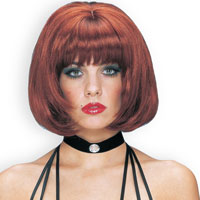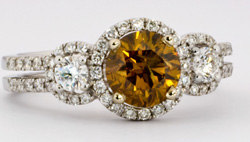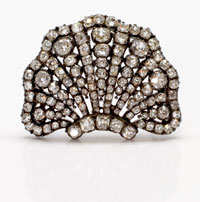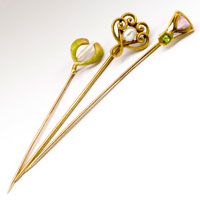 The Price of Fad
The Price of Fad
What do rough diamonds, steel engagement rings, and hip-hop jewelry have in common? They’re all popular right now, the latest fashion, and selling well. But when a fad falls out of favor, the jewelry loses value.
Jewelry sites, bridal magazines, blogs and fashion boutiques are praising unusual jewelry, vibrant gem colors, new materials, outrageous designs, styles “unique to your personality.” Celebrities wear the expensive works by famous designers; folks on a budget find cheaper renditions and adaptations.
Funky, chunky, color and splash

A chunky ring with even chunkier gemstones
For example, there’s been a rash of interest in “funky diamonds.” Traditionally, a diamond’s clarity was one of its major attractions, a strong mark of value, but now opaque diamonds have a prominent place in jewelry. Black diamonds are particularly popular.
A diamond’s cut, its expert faceting, is considered the single most important quality in determining valuation, but now there is a craze for jewelry with chunks of rough diamonds and other gems, not even polished. Some of the best designers are producing jewelry showcasing pieces of diamond rough. One advertising tag line reads: “A diamond doesn’t have to be perfect to be pretty.”

Brown and yellow diamonds, which used to be considered poor quality, “off-color” and virtually unmarketable, are now in style. The expanded palette also includes color-treated diamonds in pinks, blues and everything in between, as well as synthesized color diamonds.
And then there’s chunky jewelry. Outrageous, oversize jewelry, often “iced” with small diamonds, is an attention-getter. Bling led the way, and now hip-hop-inspired jewelry is found in all price ranges and in styles from casual to formal.

Many websites feature high-priced bling.
The palette of jewelry metals is also growing. Rugged metals such as steel, titanium and tungsten are joining the ranks alongside gold and platinum, especially for men’s jewelry. And even silver is being used more often than before because, in today’s economy, it is vastly less expensive than gold or platinum.
Designers can also come into fashion. They may grow in popularity and their works grow in value, or they may suddenly drop out of sight.
Trends

Pandora Bracelet
One thing about a fad: when you’ve gotten tired of it, probably everyone else has, too. The choker pictured at the top of this issue was popular during the 1970s—but not now. Pandora bracelets, with beads or charms added to commemorate personal events or places visited, are hot jewelry items these days but are not likely to retain that status.
Many of these trends will run their course and values will drop. Or the economy will pick up and buyers will turn again to higher quality jewelry—gold or platinum rather than silver, natural diamond rather than synthetic. Personal taste will change, and young people now buying bling will turn to more classic styles. The fashionable becomes old-fashioned.
Sometimes fashions do come back. Art Deco burst on the scene in the 1920s, and today it’s so admired that the jewelry is collected and imitated. However, it was out of favor for several decades between then and now. Probably a lot of Art Deco jewelry was melted down during the Depression, when people needed money and this jewelry was worth little more than its components.
 Georgian Brooch |
 Art Nouveau stick pins |
Art Nouveau, popular at the turn of the 20th century, seems to be making a comeback. However, not only design styles but even certain items of jewelry are subject to fashion. Stick pins and brooches, for example, are not much in demand these days.
Will rapper jewelry come to be valued 50 or 100 years from now? Will rough diamonds blend into the mainstream and become traditional choices? Will such items be sought by collectors? Perhaps the quality pieces, attractively styled and well crafted, will retain or grow in value. The rest may just look dated as a Nehru jacket, destined to be worn only as retro whimsy.
FOR AGENTS & UNDERWRITERS
Jewelry fads emphasize the importance of having a new valuation for jewelry every couple of years. Jewelry, like other material objects, takes its value from the marketplace. When people no longer want it, its value falls like a rock.
FOR ADJUSTERS
A settlement is based on value at time of loss. This is especially relevant in regard to trendy jewelry. Yesterday’s fad jewelry may be worth only the value of its metal and gem material. On the other hand, a relatively unknown designer may become famous and his works may appreciate in value.
Be sure the appraisal valuation is recent, so the insurer does not overpay or underpay a loss.
©2000-2025, JCRS Inland Marine Solutions, Inc. All Rights Reserved. www.jcrs.com


